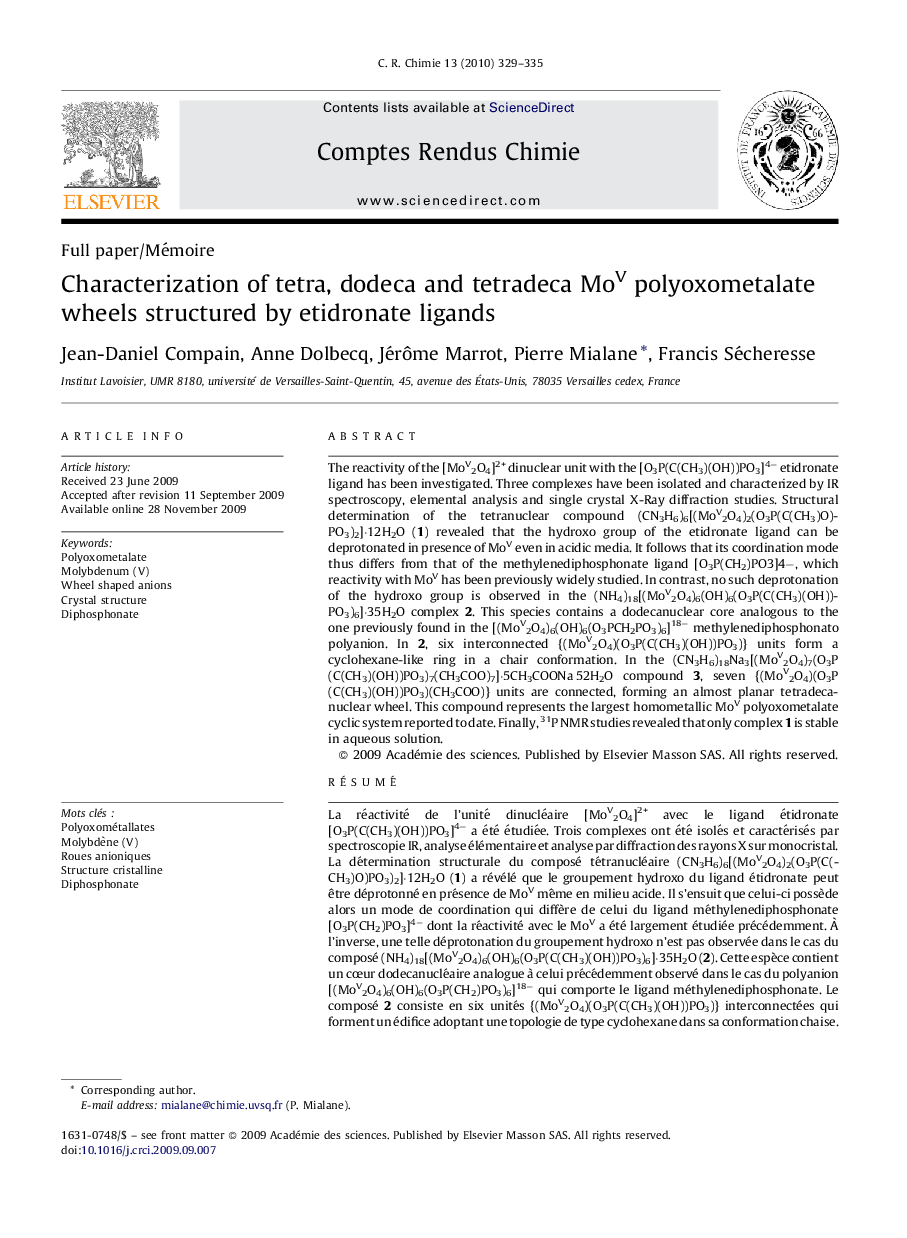| کد مقاله | کد نشریه | سال انتشار | مقاله انگلیسی | نسخه تمام متن |
|---|---|---|---|---|
| 171282 | 458446 | 2010 | 7 صفحه PDF | دانلود رایگان |

The reactivity of the [MoV2O4]2+ dinuclear unit with the [O3P(C(CH3)(OH))PO3]4− etidronate ligand has been investigated. Three complexes have been isolated and characterized by IR spectroscopy, elemental analysis and single crystal X-Ray diffraction studies. Structural determination of the tetranuclear compound (CN3H6)6[(MoV2O4)2(O3P(C(CH3)O)PO3)2]·12H2O (1) revealed that the hydroxo group of the etidronate ligand can be deprotonated in presence of MoV even in acidic media. It follows that its coordination mode thus differs from that of the methylenediphosphonate ligand [O3P(CH2)PO3]4−, which reactivity with MoV has been previously widely studied. In contrast, no such deprotonation of the hydroxo group is observed in the (NH4)18[(MoV2O4)6(OH)6(O3P(C(CH3)(OH))PO3)6]·35H2O complex 2. This species contains a dodecanuclear core analogous to the one previously found in the [(MoV2O4)6(OH)6(O3PCH2PO3)6]18− methylenediphosphonato polyanion. In 2, six interconnected {(MoV2O4)(O3P(C(CH3)(OH))PO3)} units form a cyclohexane-like ring in a chair conformation. In the (CN3H6)18Na3[(MoV2O4)7(O3P(C(CH3)(OH))PO3)7(CH3COO)7]·5CH3COONa 52H2O compound 3, seven {(MoV2O4)(O3P(C(CH3)(OH))PO3)(CH3COO)} units are connected, forming an almost planar tetradecanuclear wheel. This compound represents the largest homometallic MoV polyoxometalate cyclic system reported to date. Finally, 31P NMR studies revealed that only complex 1 is stable in aqueous solution.
RésuméLa réactivité de l’unité dinucléaire [MoV2O4]2+ avec le ligand étidronate [O3P(C(CH3)(OH))PO3]4− a été étudiée. Trois complexes ont été isolés et caractérisés par spectroscopie IR, analyse élémentaire et analyse par diffraction des rayons X sur monocristal. La détermination structurale du composé tétranucléaire (CN3H6)6[(MoV2O4)2(O3P(C(CH3)O)PO3)2]·12H2O (1) a révélé que le groupement hydroxo du ligand étidronate peut être déprotonné en présence de MoV même en milieu acide. Il s’ensuit que celui-ci possède alors un mode de coordination qui diffère de celui du ligand méthylenediphosphonate [O3P(CH2)PO3]4− dont la réactivité avec le MoV a été largement étudiée précédemment. À l’inverse, une telle déprotonation du groupement hydroxo n’est pas observée dans le cas du composé (NH4)18[(MoV2O4)6(OH)6(O3P(C(CH3)(OH))PO3)6]·35H2O (2). Cette espèce contient un cœur dodecanucléaire analogue à celui précédemment observé dans le cas du polyanion [(MoV2O4)6(OH)6(O3P(CH2)PO3)6]18− qui comporte le ligand méthylenediphosphonate. Le composé 2 consiste en six unités {(MoV2O4)(O3P(C(CH3)(OH))PO3)} interconnectées qui forment un édifice adoptant une topologie de type cyclohexane dans sa conformation chaise. Dans le cas du composé (CN3H6)18Na3[(MoV2O4)7(O3P(C(CH3)(OH))PO3)7(CH3COO)7]·5CH3COONa 52H2O (3), sept unités {(MoV2O4)(O3P(C(CH3)(OH))PO3)(CH3COO)} sont connectées, formant une roue tétradécanucléaire quasiment plane. Ce composé représente le polyoxométallate cyclique ne comportant que des ions métalliques MoV de plus haute nucléarité reporté à ce jour. Finalement, des études par RMN du 31P ont révélé que seul le complexe 1 est stable en solution.
Figure optionsDownload as PowerPoint slide
Journal: Comptes Rendus Chimie - Volume 13, Issue 3, March 2010, Pages 329–335